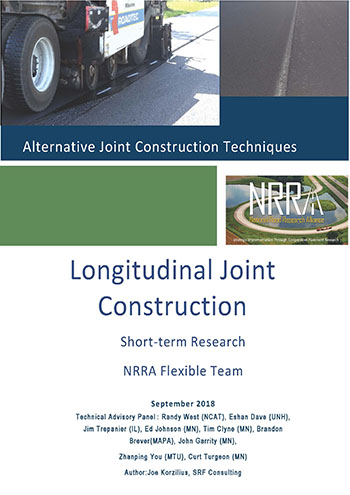5 Factors for Successful Longitudinal Joint Construction
It’s easy to say that good workmanship is the key to a good longitudinal joint, but good construction is a combination of specific factors. A recent report completed by the NRRA Flexible Team digs into those specific factors and outlines some elements you should focus on. The DOTs that contributed to this report include:
- California
- Illinois
- Michigan
- Minnesota
- Missouri
- Wisconsin
“The longitudinal joint is the weakest link in the chain” said John Garrity, bituminous engineer for MnDOT’s Materials and Road Research Group. Density is key to pavement durability, he said, and it’s difficult to maintain density across the mat at that place where the first and second pass of the paver meet—the longitudinal joint. Here are some factors to double check during construction.
Straight Lines
This may sound like a no brainer, but you need to have a straight reference line for the paver to follow during the first pass. The report suggests a simple stringline for the reference line. Whatever you use to establish this line, don’t forget to do it.
Steel First
When the rollers start compacting the mats, the report recommends that you begin with a steel  roller (rather than rubber) with a 6-inch overhang from the hot side of the mat. The issue with asphalt compaction, says Garrity, is when you have an unconfined edge, the asphalt will want to move laterally at that edge and then you lose density. Rubber rollers on an unconfined edge will mush out the mix if positioned too closely to the edge.
roller (rather than rubber) with a 6-inch overhang from the hot side of the mat. The issue with asphalt compaction, says Garrity, is when you have an unconfined edge, the asphalt will want to move laterally at that edge and then you lose density. Rubber rollers on an unconfined edge will mush out the mix if positioned too closely to the edge.
Overlap
Make sure, during the second (adjacent) paver pass, that the screed is overlapping the first paver pass by 1-1.5 inches. Moreover, the overlap should be about ¼ inch higher than the adjacent mat before the rollers compact the joint.
Roller Placement
There are two schools of thought on this. The two-pass method puts the first roller pass on the hot mat and six inches from the joint. On the second pass, the roller goes directly over the joint, essentially pinching the material in place.
The other method only does one pass with the roller 6 inches over the joint from the hot mat side.
Joint Shape
The six states diverge on how to construct the actual joint. One method, preferred by all the states except Minnesota and Missouri, is called the Notched Wedge Joint. With this joint, the screed has a form attached on the end so it shapes a notched, tapered edge on the first pass. This taper is about 12 inches wide depending on lift thickness. On the second paver pass, the screed overlaps the first paver pass and fills in the notched wedge.
The other joint is called the Maryland Joint--it is a butt joint and therefore neither notched nor tapered. It’s just a straight edge abutted up against another straight edge with enough overlap to ensure the best density when compacted.
The importance of density at the joint cannot be stressed enough, says Garrity, because the less density in the longitudinal joint, the more porous it is. That means water can get in the joint and reduce the performance of the material. Cracks in the longitudinal joint are made even worse in multilane roads where cars change lanes a lot. When it rains, these cars go over the joints and push water into cracks “like a pressure sprayer” he says.
As an added precaution, both Illinois and Minnesota apply a longitudinal joint adhesive before paving the adjacent paving pass in order to help keep the water out of the joint. Photos in the report show how these joint sealers are performing.
